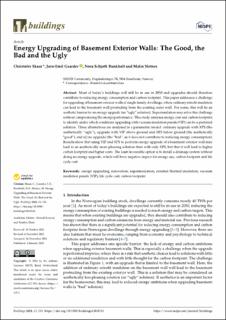| dc.contributor.author | Skaar, Christofer | |
| dc.contributor.author | Gaarder, Jørn Emil | |
| dc.contributor.author | Bunkholt, Nora Schjøth | |
| dc.contributor.author | Sletnes, Malin | |
| dc.date.accessioned | 2023-02-16T10:34:30Z | |
| dc.date.available | 2023-02-16T10:34:30Z | |
| dc.date.created | 2023-02-04T16:15:13Z | |
| dc.date.issued | 2023 | |
| dc.identifier.issn | 2075-5309 | |
| dc.identifier.uri | https://hdl.handle.net/11250/3051429 | |
| dc.description.abstract | Most of today’s buildings will still be in use in 2050 and upgrades should therefore contribute to reducing energy consumption and carbon footprint. This paper addresses a challenge for upgrading of basement exterior walls of single-family dwellings, where ordinary retrofit insulation can lead to the basement wall protruding from the existing outer wall. For some, this will be an aesthetic barrier for an energy upgrade (an “ugly” solution). Superinsulation may solve this challenge without compromising the energy performance. This study analyses energy, cost and carbon footprint, to identify under which conditions upgrading with vacuum insulation panels (VIP) can be a preferred solution. Three alternatives are analysed in a parametric model: ordinary upgrade with XPS (the aesthetically “ugly”), upgrade with VIP above ground and XPS below ground (the aesthetically “good”), and iii) no upgrade (the “bad”, as it does not contribute to reducing energy consumption). Results show that using VIP and XPS to perform energy upgrade of a basement exterior wall may lead to an aesthetically more pleasing solution than with only XPS, but that it will lead to higher carbon footprint and higher costs. The least favourable option is to install a drainage system without doing an energy upgrade, which will have negative impact for energy use, carbon footprint and life cycle cost. | en_US |
| dc.language.iso | eng | en_US |
| dc.publisher | MDPI | en_US |
| dc.rights | CC BY 4.0 | * |
| dc.rights.uri | http://creativecommons.org/licenses/by/4.0/ | * |
| dc.subject | Energy upgrading | en_US |
| dc.subject | Renovation | en_US |
| dc.subject | Superinsulation | en_US |
| dc.subject | External thermal insulation | en_US |
| dc.subject | Vacuum insulation panels (VIP) | en_US |
| dc.subject | Life cycle cost | en_US |
| dc.subject | Carbon footprint | en_US |
| dc.title | Energy Upgrading of Basement ExteriorWalls: The Good, the Bad and the Ugly | en_US |
| dc.type | Peer reviewed | en_US |
| dc.type | Journal article | en_US |
| dc.description.version | publishedVersion | en_US |
| dc.rights.holder | © 2023 The authors | en_US |
| dc.subject.nsi | VDP::Teknologi: 500 | en_US |
| dc.source.volume | 13 | en_US |
| dc.source.journal | Buildings | en_US |
| dc.source.issue | 1 | en_US |
| dc.identifier.doi | 10.3390/buildings13010133 | |
| dc.identifier.cristin | 2123026 | |
| dc.relation.project | Norges forskningsråd: 282389 | en_US |
| dc.source.articlenumber | 133 | en_US |
| cristin.ispublished | true | |
| cristin.fulltext | original | |
| cristin.qualitycode | 1 | |

